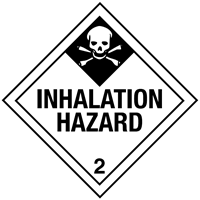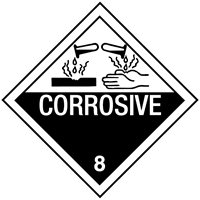
 Print
Print
Chemical Datasheet
BORON TRIFLUORIDE |


|
Chemical Identifiers
| CAS Number |
UN/NA Number |
DOT Hazard Label |
USCG CHRIS Code |
- 7637-07-2

|
|
|
none
|
| NIOSH Pocket Guide |
International Chem Safety Card |
|
Boron trifluoride
|
|
NFPA 704
General Description
Boron trifluoride is a colorless gas with a pungent odor. It is toxic by inhalation. It is soluble in water and slowly hydrolyzed by cold water to give off hydrofluoric acid, a corrosive material. Its vapors are heavier than air. Prolonged exposure of the containers to fire or heat may result in their violent rupturing and rocketing.
Hazards
Reactivity Alerts
- Known Catalytic Activity
- Water-Reactive
- Air-Reactive
Air & Water Reactions
Fumes in air. Soluble in water and slowly hydrolyzed by cold water to give hydrofluoric acid. Reacts more rapidly with hot water.
Fire Hazard
When heated to decomposition or upon contact with water or steam, it will produce toxic and corrosive fumes of fluorine containing compounds. Decomposes upon heating or on contact with moist air, forming toxic and corrosive fumes of boric acid and hydrofluoric acid. Reacts with alkalis and fumes in moist air, producing particulates which reduce visibility. Reacts with alkali metals, alkaline earth metals (except magnesium), alkyl nitrates, and calcium oxide. It hydrolyzes in moist air to form boric acid, hydrofluoric acid, and fluoboric acid. (EPA, 1998)
Health Hazard
Highly toxic; may cause death or permanent injury after very short exposure to small quantities. Substance is irritating to the eyes, the skin, and the respiratory tract. (EPA, 1998)
Reactivity Profile
BORON TRIFLUORIDE is a colorless, strongly irritating, toxic gas. Upon contact with water, steam or when heated to decomposition, it will produce toxic fluoride fumes. Incompatible with alkyl nitrates, calcium oxide. Reaction with alkali metals or alkaline earth metals (except magnesium) will cause incandescence [Bretherick, 5th ed., 1995, p. 65].
Belongs to the Following Reactive Group(s)
- Fluoride Salts, Soluble
- Acids, Weak
Potentially Incompatible Absorbents
Use caution: Liquids with this reactive group classification have been
known to react with the
absorbents
listed below.
- Mineral-Based & Clay-Based Absorbents
- Sand
- Dirt/Earth
Response Recommendations
Isolation and Evacuation
Excerpt from ERG Guide 125 [Gases - Toxic and/or Corrosive]:
IMMEDIATE PRECAUTIONARY MEASURE: Isolate spill or leak area for at least 100 meters (330 feet) in all directions.
SPILL: See ERG Table 1 - Initial Isolation and Protective Action Distances on the UN/NA 1008 datasheet.
FIRE: If tank, rail tank car or highway tank is involved in a fire, ISOLATE for 1600 meters (1 mile) in all directions; also, consider initial evacuation for 1600 meters (1 mile) in all directions. (ERG, 2024)
Firefighting
Keep unnecessary people away; isolate hazard area and deny entry. Stay upwind; keep out of low areas. Ventilate closed spaces before entering them. Wear positive pressure breathing apparatus and full protective clothing. Evacuate area endangered by gas. Do not get water inside container. Move container from fire area if you can do it without risk. Stay away from ends of tanks. Cool containers that are exposed to flames with water from the side until well after fire is out. Isolate area until gas has dispersed.
Extinguish with dry chemical, carbon dioxide, water spray, fog, or foam. (EPA, 1998)
Non-Fire Response
Excerpt from ERG Guide 125 [Gases - Toxic and/or Corrosive]:
Do not touch or walk through spilled material. Stop leak if you can do it without risk. If possible, turn leaking containers so that gas escapes rather than liquid. Prevent entry into waterways, sewers, basements or confined areas. Do not direct water at spill or source of leak. Use water spray to reduce vapors or divert vapor cloud drift. Avoid allowing water runoff to contact spilled material. Isolate area until gas has dispersed. (ERG, 2024)
Protective Clothing
Excerpt from NIOSH Pocket Guide for Boron trifluoride:
Skin: No recommendation is made specifying the need for personal protective equipment for the body.
Eyes: No recommendation is made specifying the need for eye protection.
Wash skin: No recommendation is made specifying the need for washing the substance from the skin (either immediately or at the end of the work shift).
Remove: No recommendation is made specifying the need for removing clothing that becomes wet or contaminated.
Change: No recommendation is made specifying the need for the worker to change clothing after the workshift. (NIOSH, 2024)
DuPont Tychem® Suit Fabrics
Normalized Breakthrough Times (in Minutes)
| Chemical |
CAS Number |
State |
QS |
QC |
SL |
C3 |
TF |
TP |
RC |
TK |
RF |
| Boron trifluoride |
7637-07-2 |
Vapor |
|
|
|
|
|
|
>480 |
>480 |
>480 |
Special Warning from DuPont: Tychem® and Tyvek® fabrics should not be
used around heat, flames, sparks or in potentially flammable or
explosive environments. Only...
(DuPont, 2024)
First Aid
Warning: Boron trifluoride is extremely corrosive. Caution is advised.
Signs and Symptoms of Acute Boron Trifluoride Exposure: Acute inhalation exposure of boron trifluoride may result in sneezing, hoarseness, choking, laryngitis, and respiratory tract irritation. Bleeding of the nose and gums, ulceration of the nasal and oral mucosa, bronchitis, pneumonia, dyspnea (shortness of breath), chest pain, and pulmonary edema may also occur. If the eyes have come in contact with boron trifluoride, irritation, pain, swelling, corneal erosion, and blindness may result. Dermal exposure may result in dermatitis (red, inflamed skin), severe burns, and pain.
Emergency Life-Support Procedures: Acute exposure to boron trifluoride may require decontamination and life support for the victims. Emergency personnel should wear protective clothing appropriate to the type and degree of contamination. Air-purifying or supplied-air respiratory equipment should also be worn, as necessary. Rescue vehicles should carry supplies such as plastic sheeting and disposable plastic bags to assist in preventing spread of contamination.
Inhalation Exposure:
1. Move victims to fresh air. Emergency personnel should avoid self-exposure to boron trifluoride.
2. Evaluate vital signs including pulse and respiratory rate, and note any trauma. If no pulse is detected, provide CPR. If not breathing, provide artificial respiration. If breathing is labored, administer oxygen or other respiratory support.
3. Obtain authorization and/or further instructions from the local hospital for administration of an antidote or performance of other invasive procedures.
4. RUSH to a health care facility.
Dermal/Eye Exposure:
1. Remove victims from exposure. Emergency personnel should avoid self- exposure to boron trifluoride.
2. Evaluate vital signs including pulse and respiratory rate, and note any trauma. If no pulse is detected, provide CPR. If not breathing, provide artificial respiration. If breathing is labored, administer oxygen or other respiratory support.
3. Remove contaminated clothing as soon as possible.
4. If eye exposure has occurred, eyes must be flushed with lukewarm water for at least 15 minutes.
5. Wash exposed skin areas THOROUGHLY with soap and water.
6. Obtain authorization and/or further instructions from the local hospital for administration of an antidote or performance of other invasive procedures.
7. RUSH to a health care facility.
Ingestion Exposure:
1. Evaluate vital signs including pulse and respiratory rate, and note any trauma. If no pulse is detected, provide CPR. If not breathing, provide artificial respiration. If breathing is labored, administer oxygen or other respiratory support. Humidified oxygen is preferred.
2. IMMEDIATELY give the victims milk or water to dilute the hydrofluoric acid: children up to 1 year old, 125 mL (4 oz or 1/2 cup); children 1 to 12 years old, 200 mL (6 oz or 3/4 cup); adults, 250 mL (8 oz or 1 cup). Milk or water should be given only if victims are conscious and alert.
3. DO NOT induce vomiting.
4. Milk of Magnesia should be administered if victims are conscious and alert. Use
2.5 mL (1/2 tsp) for children up to 1 year old, 5 mL (1 tsp) for children 1 to 12 years old, and 10 mL (2 tsp) for adults. Do not exceed 15 mL (3 tsp or 1 tbsp).
5. Obtain authorization and/or further instructions from the local hospital for administration of an antidote or performance of other invasive procedures.
6. Activated charcoal is of no value.
7. Repeat the administration of water or milk to conscious and alert victims. Use quantities listed above (see No. 2).
8. Transport to a health care facility. (EPA, 1998)
Physical Properties
Flash Point: data unavailable
Lower Explosive Limit (LEL):
Not Flammable.
(EPA, 1998)
Upper Explosive Limit (UEL):
Not Flammable.
(EPA, 1998)
Autoignition Temperature: data unavailable
Melting Point:
-196.1°F
(EPA, 1998)
Vapor Pressure:
760 mmHg
at -149.26°F
Liquid
(EPA, 1998)
Vapor Density (Relative to Air):
2.4
(EPA, 1998)
- Heavier than air; will sink
Specific Gravity:
1.6
(EPA, 1998)
- Denser than water; will sink
Boiling Point:
-148°F
at 760 mmHg
(NIOSH, 2024)
Molecular Weight:
67.82
(EPA, 1998)
Water Solubility:
106 %
(in cold H2O)
(NIOSH, 2024)
Ionization Energy/Potential:
15.50 eV
(NIOSH, 2024)
IDLH:
25 ppm
(NIOSH, 2024)
AEGLs (Acute Exposure Guideline Levels)
Final AEGLs for Boron trifluoride (7637-07-2)
| Exposure Period |
AEGL-1 |
AEGL-2 |
AEGL-3 |
| 10 minutes |
2.5 mg/m3 |
37 mg/m3 |
110 mg/m3 |
| 30 minutes |
2.5 mg/m3 |
37 mg/m3 |
110 mg/m3 |
| 60 minutes |
2.5 mg/m3 |
29 mg/m3 |
88 mg/m3 |
| 4 hours |
2.5 mg/m3 |
18 mg/m3 |
55 mg/m3 |
| 8 hours |
2.5 mg/m3 |
9.3 mg/m3 |
28 mg/m3 |
(NAC/NRC, 2024)
ERPGs (Emergency Response Planning Guidelines)
| Chemical |
ERPG-1 |
ERPG-2 |
ERPG-3 |
| Boron Trifluoride (7637-07-2)
|
2 mg/m3  |
30 mg/m3 |
100 mg/m3 |
(AIHA, 2022)
PACs (Protective Action Criteria)
| Chemical |
PAC-1 |
PAC-2 |
PAC-3 |
| Boron trifluoride (7637-07-2)
|
2.5 mg/m3 |
29 mg/m3 |
88 mg/m3 |
(DOE, 2024)
Regulatory Information
EPA Consolidated List of Lists
| Regulatory Name |
CAS Number/
313 Category Code |
EPCRA 302
EHS TPQ |
EPCRA 304
EHS RQ |
CERCLA RQ |
EPCRA 313
TRI |
RCRA
Code |
CAA 112(r)
RMP TQ |
| Borane, trifluoro- |
7637-07-2 |
500 pounds |
500 pounds |
|
X |
|
5000 pounds |
| Boron trifluoride |
7637-07-2 |
500 pounds |
500 pounds |
|
313 |
|
5000 pounds |
(EPA List of Lists, 2024)
CISA Chemical Facility Anti-Terrorism Standards (CFATS)
|
RELEASE |
THEFT |
SABOTAGE |
| Chemical of Interest |
CAS Number |
Min Conc |
STQ |
Security
Issue |
Min Conc |
STQ |
Security
Issue |
Min Conc |
STQ |
Security
Issue |
| Boron trifluoride; [Borane, trifluoro] |
7637-07-2 |
1.00 % |
5000 pounds |
toxic |
26.87 % |
45 pounds |
WME |
|
|
|
(CISA, 2007)
OSHA Process Safety Management (PSM) Standard List
| Chemical Name |
CAS Number |
Threshold Quantity (TQ) |
| Boron Trifluoride |
7637-07-2 |
250 pounds |
(OSHA, 2019)
Alternate Chemical Names
- ANCA 1040
- BORANE, TRIFLUORO-
- BORON FLUORIDE
- BORON FLUORIDE (BF3)
- BORON FLUORIDE(BF3)
- BORON TRIFLUORIDE
- BORON TRIFLUORIDE, COMPRESSED
- TRIFLUOROBORANE
- TRIFLUOROBORON



 Print
Print

